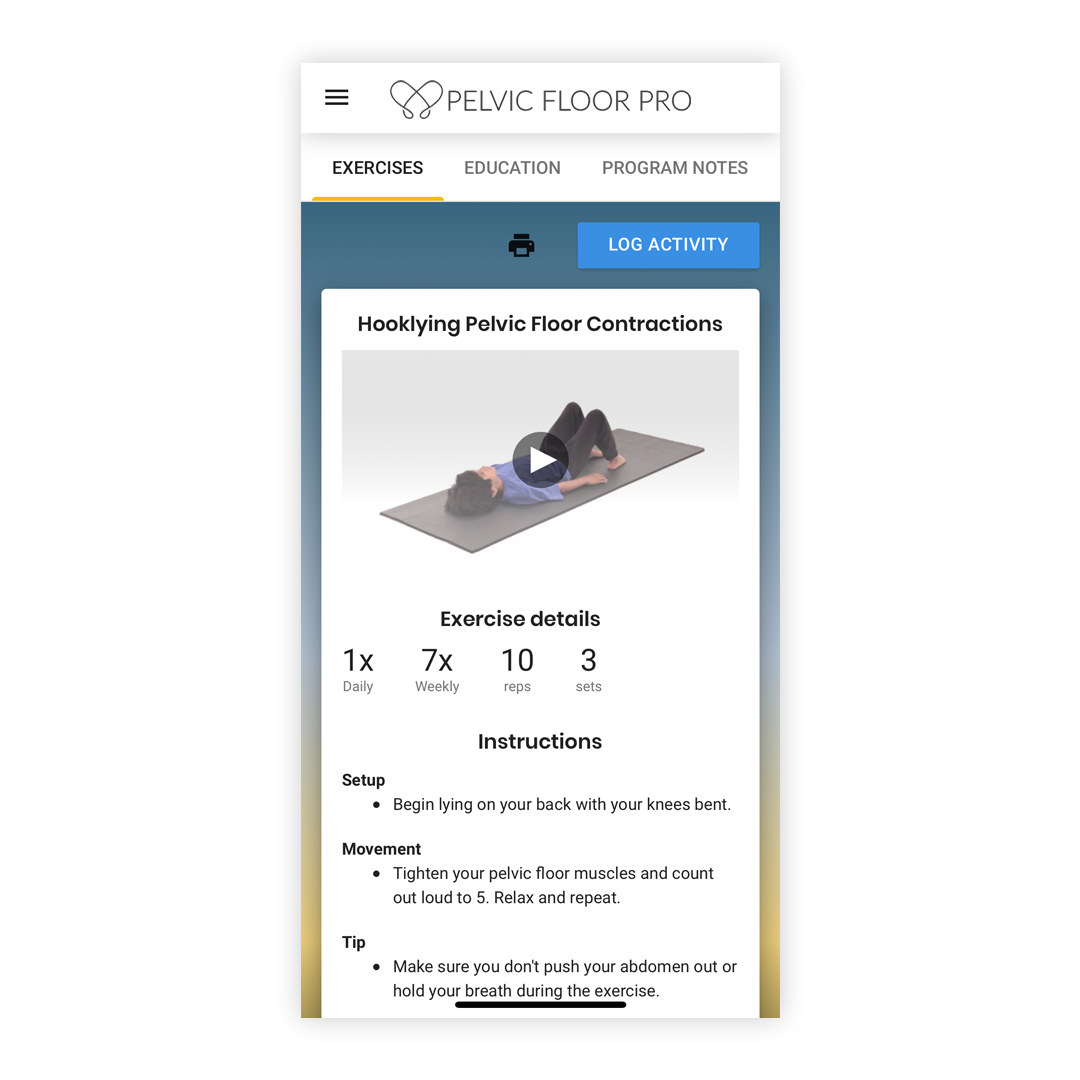
Preparing the pelvic floor region for pregnancy is essential as the body undergoes significant changes both hormonally and physically. The prenatal period is the perfect time to prepare the body for these significant changes, specifically with prenatal pelvic floor exercises. Pregnancy is one of the most, if not the most stress the pelvic floor will ever be put under. The entire body and all our systems are impacted by pregnancy, as the whole body is intricately connected. Engaging with regular pelvic floor specific exercises in the prenatal period can help reduce the severity of pregnancy and postnatal physical impacts on the body. It will best prepare the body for a much easier pregnancy in the later stages, during delivery, and in the postnatal period. It is better to be proactive in targeting and treating pain and discomfort and preventing issues arising than reactive as they appear.
…
Pelvic floor exercises app. Wherever you are — whatever device.

…
When should you start doing pelvic floor exercises in pregnancy?

It is best to start doing pelvic floor exercises in the prenatal period, to prepare for the changes faced during the later stages of pregnancy and the postnatal period. Prenatal pelvic floor exercises help reduce the discomfort caused by postural changes, changes in the abdomen including stretching of the abdominal muscle wall, rib cage expansion, changes to the pelvic floor region, and organ pressure and placement. As all our muscles, bones, joints, and ligaments are connected (our musculoskeletal system), the significant changes a woman faces physically in pregnancy can be felt throughout the entire body.
It is best to see a pelvic floor physical therapist whilst in the postnatal period, to undergo an assessment and devise a potential treatment plan to address any occurring musculoskeletal issues and pelvic floor discomfort before the pregnancy progresses, if required. This will involve a pelvic floor assessment to identify areas of pain or dysfunction. Appropriate exercises based on the client’s assessment and needs will then be prescribed to address these dysfunctions and therefore allow the patient to re-engage with their pelvic floor muscles. This proactive approach will assist with reducing pregnancy symptoms and potential preventative issues arising. This includes reducing the physical stress impact on the pelvic floor region throughout pregnancy and in the postnatal period.
More specifically, if the client is experiencing tightness in their pelvic floor region, this will be addressed as to reduce discomfort faced during pregnancy. Pelvic floor dysfunction, including areas of tightness, is extremely common even for the non-pregnant woman. Therefore we can’t stress enough the importance of addressing these issues before you undergo some big physical and hormonal changes.
Are pelvic floor exercises safe during pregnancy?

Pelvic floor exercises are not unsafe and are recommended during pregnancy. Engaging in pelvic floor exercises that are prescribed by a pelvic floor physical therapist as early as possible in the pregnancy journey is one of the most beneficial things you can do for your body at this time. It will reduce the risk of complications, the intensity of symptoms, and discomfort induced by pregnancy. Having a strong pelvic floor will prepare your body for a smoother pregnancy period, including supporting the baby and minimizing symptoms induced by the increased bladder pressure. The delivery period will also be smoother, as the baby can rotate as necessary during the labor. Further, common symptoms faced in the postnatal period such as pelvic floor prolapse, incontinence, and muscle dysfunctions can be reduced in severity or avoided altogether.
Luckily, prenatal pelvic floor exercises can be completed in sitting, lying, or standing to cater to the patient’s needs. Specific exercises that align with the client’s needs post-assessment, are prescribed by a pelvic floor physical therapist.
How can I strengthen my pelvic floor muscles during pregnancy?
After a pelvic floor assessment by a pelvic floor physical therapist, engaging with specifically prescribed exercises in the prenatal period is the best way to strengthen the pelvic floor muscles for birth and the postnatal period. It is best to always go for less but more high-quality repetitions than lots of poorly executed repetitions of the exercises prescribed to the patient.
Completing pelvic floor exercises should be integrated into your daily routine to have the best outcome from a strength basis. It is about building muscular endurance and forming new musculoskeletal habits which will be beneficial in the later stages, delivery, and postnatal period of pregnancy.
3 Myths About The Pelvic Floor – Download Our FREE Ebook Now

Use the form below to download our ebook and start your pelvic health journey.
Pelvic Exercises During Pregnancy Third Trimester

The third trimester of pregnancy is defined as week 29 to 40 of pregnancy. It is recommended that you continue to engage in physical exercise, including prenatal pelvic floor exercises during the third trimester of pregnancy as this is a crucial time in your baby’s growth and development cycle. As your baby continues to grow in size and weight, the more strength your pelvic floor muscles will need to support the increased pressure on the pelvic floor region. Interestingly, a hormone is known as relaxin increases in the latter stages of pregnancy to soften the pelvic floor region and prepare it for birth. This can cause symptoms including incontinence, pelvic pain, and back pain. A pelvic floor that is stronger will be more resistant to severe symptoms or may avoid a few or all of them, all together.
Pelvic Tilt Exercise Pregnancy

Pelvic tilt exercises during pregnancy assist in strengthening the muscles and ligaments of the pelvic floor region and around the area, including those in the lower back, hips, thighs, and abdominal muscles. Pelvic tilts need to be done in a mentally and physically engaged state, with slow, focused repetitions, rather than lots of fast and uncontrolled movements. When completing pelvic tilt exercises, you’re working with the spinal region, both gently massaging the spine and strengthening the areas mentioned above. These exercises are versatile, as they can be completed standing, on hands and knees, and utilizing specific equipment such as an exercise ball.
Think about it in an athletic sense – if you were preparing your body for a big event, you’d want to engage in thoughtful, specific exercises. Pregnancy places a lot of stress on the body, so it is important to prepare it for the physical and hormonal changes ahead.
…
Pelvic floor exercises app. Wherever you are — whatever device.

…

